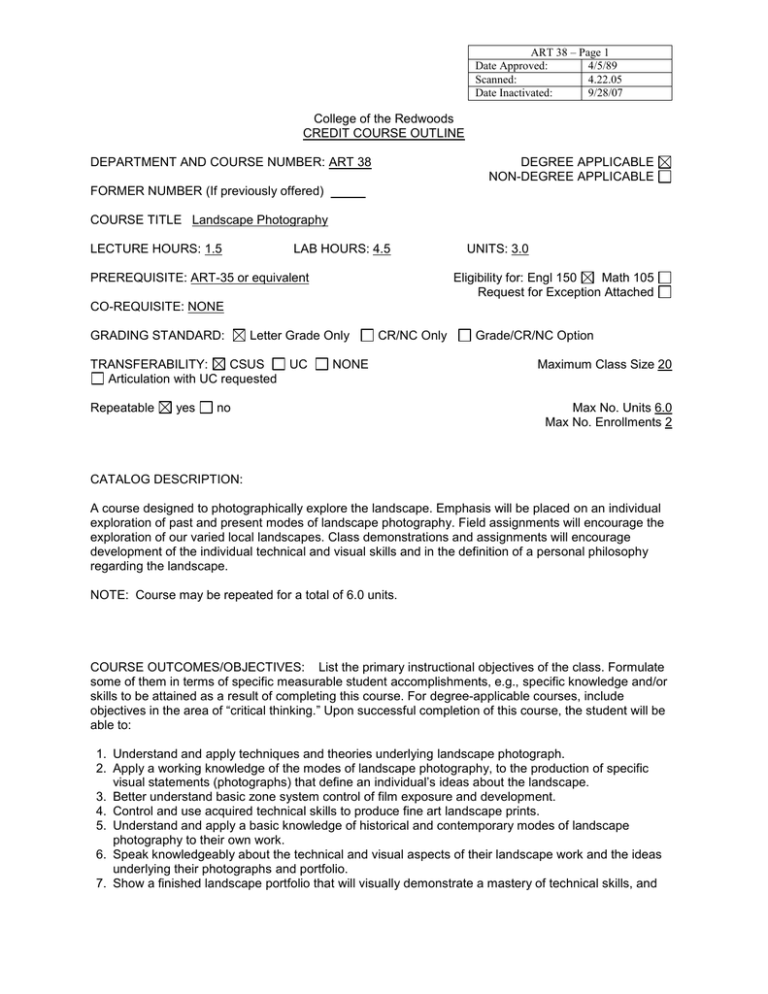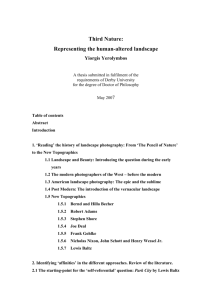College of the Redwoods CREDIT COURSE OUTLINE
advertisement

ART 38 – Page 1 Date Approved: 4/5/89 Scanned: 4.22.05 Date Inactivated: 9/28/07 College of the Redwoods CREDIT COURSE OUTLINE DEPARTMENT AND COURSE NUMBER: ART 38 DEGREE APPLICABLE NON-DEGREE APPLICABLE FORMER NUMBER (If previously offered) COURSE TITLE Landscape Photography LECTURE HOURS: 1.5 LAB HOURS: 4.5 PREREQUISITE: ART-35 or equivalent UNITS: 3.0 Eligibility for: Engl 150 Math 105 Request for Exception Attached CO-REQUISITE: NONE GRADING STANDARD: Letter Grade Only TRANSFERABILITY: CSUS UC Articulation with UC requested Repeatable yes CR/NC Only NONE no Grade/CR/NC Option Maximum Class Size 20 Max No. Units 6.0 Max No. Enrollments 2 CATALOG DESCRIPTION: A course designed to photographically explore the landscape. Emphasis will be placed on an individual exploration of past and present modes of landscape photography. Field assignments will encourage the exploration of our varied local landscapes. Class demonstrations and assignments will encourage development of the individual technical and visual skills and in the definition of a personal philosophy regarding the landscape. NOTE: Course may be repeated for a total of 6.0 units. COURSE OUTCOMES/OBJECTIVES: List the primary instructional objectives of the class. Formulate some of them in terms of specific measurable student accomplishments, e.g., specific knowledge and/or skills to be attained as a result of completing this course. For degree-applicable courses, include objectives in the area of “critical thinking.” Upon successful completion of this course, the student will be able to: 1. Understand and apply techniques and theories underlying landscape photograph. 2. Apply a working knowledge of the modes of landscape photography, to the production of specific visual statements (photographs) that define an individual’s ideas about the landscape. 3. Better understand basic zone system control of film exposure and development. 4. Control and use acquired technical skills to produce fine art landscape prints. 5. Understand and apply a basic knowledge of historical and contemporary modes of landscape photography to their own work. 6. Speak knowledgeably about the technical and visual aspects of their landscape work and the ideas underlying their photographs and portfolio. 7. Show a finished landscape portfolio that will visually demonstrate a mastery of technical skills, and ART 38 – Page 2 Date Approved: 4/5/89 Scanned: 4.22.05 Date Inactivated: 9/28/07 will make an informed visual statement, illustrating styles and techniques relevant to landscape work. COURSE OUTLINE: % of Classroom Hours Spent on Each Topic Course introduction, assignment summary, portfolio, critiques, grading and material 5% Historical and contemporary trends in landscape photography 10% The zone system as applied to the exposure and development of black and white film for landscape photography 5% Lighting problems and solutions in landscape photography 5% Special techniques of testing, developing, printing and processing landscape prints 10% View cameras, lenses, and equipment and their uses in landscape photography Processing view camera film 5% Oral reports - relating the work of (a) specific landscape photographer(s) to the photographs a student is attempting for their portfolio. Requires a technical, visual, and aesthetic comparison/contrast and analysis of visual ideas 10% Critiques - share and analyze the work of each student, both specific assignments and individually produces images (ideas) 15% Final portfolio analysis 5% Homework assignment review 5% Lecture presentations, technical demonstrations 5% Preservation and presentation of landscape photographs 2.5% Portfolio production and presentation 2.5% Homework, worksheets, quizzes and exams - in class reviews of material covered 5% Assignments in landscape photography 5% Understanding color in landscape photography 5% APPROPRIATE TEXTS AND MATERIALS: (Indicate textbooks that may be required or recommended, including alternate texts that may be used.) Text (s) Title: The Land-20th Century Landscape Photographers Required Edition:____ Alternate Author: Bill Brant Recommended Publisher: Decapro Press Date Published: 1976 (Additional required, alternate, or recommended texts should be listed on a separate sheet and attached.) For degree applicable courses the adopted texts have been certified to be college-level: Yes. Basis for determination: is used by two or more four-year colleges or universities (certified by the Division Chair or Branch Coordinator, or Center Dean) OR has been certified by the LAC as being of college level using the Coleman and Dale—Chall Readability Index Scale. No. Request for Exception Attached If no text or a below college level text is used in a degree applicable course must have a minimum of one response in category 1, 2, or 3. If category 1 is not checked, the department must explain why substantial writing assignments are an inappropriate basis for at least part of the grade. 1. Substantial writing assignments, including: essay exam(s) term or other paper(s) written homework reading report(s) laboratory report(s) other (specify) _____ ART 38 – Page 3 Date Approved: 4/5/89 Scanned: 4.22.05 Date Inactivated: 9/28/07 If the course is degree applicable, substantial writing assignments in this course are inappropriate because: The course is primarily computational in nature. The course primarily involves skill demonstrations or problem solving. Other rationale (explain) production of visual images and completion of visual assignments demonstrate satisfactory solution of technical and visual problems 2. Computational or Non-computational problem-solving demonstrations, including: exam(s) quizzes homework problems laboratory report(s) field work other (specify)_technical and visual assignments 3. Skill demonstrations, including: class performance(s) field work performance exam(s) other (specify) completion of visual and technical assignments and final portfolio in class critiques. 4. Objective examinations, including: multiple choice completion true/false other (specify) matching items 5. Other (specify) attendance, individual effort and participation in class critiques. NOTE: A course grade may not be based solely on attendance. REQUIRED READING, WRITING, AND OTHER OUTSIDE OF CLASS ASSIGNMENTS: Over an 18-week presentation of the course, 3 hours per week are required for each unit of credit. ALL Degree Applicable Credit classes must treat subject matter with a scope and intensity which require the student to study outside of class. Two hours of independent work done out of class are required for each hour of lecture. Lab and activity classes must also require some outside of class work. Outside of the regular class time the students in this class will be doing the following: Study Answer questions Skill practice Required reading Problem solving Written work (essays/compositions/report/analysis/research) Journal (reaction and evaluation of class, done on a continuing basis throughout the semester) Observation of or participation in an activity related to course content (e.g., play, museum, concert, debate, meeting, etc.) Field trips Other (specify) _Library research/oral report, outside class photography assignments, photograph for completion of final portfolio ART 38 – Page 4 Date Approved: 4/5/89 Scanned: 4.22.05 Date Inactivated: 9/28/07 COLLEGE LEVEL CRITICAL THINKING TASKS/ASSIGNMENTS: Degree applicable courses must include critical thinking tasks/assignments. This section need not be completed for non-degree applicable courses. Describe how the course requires students to independently analyze, synthesize, explain, assess, anticipate and/or define problems, formulate and assess solutions, apply principles to new situations, etc. 1. Textbook Worksheet Assignments - Require students to understand, define, and refine the basic technical, visual, and aesthetic concepts that are used in landscape photography and to relate and incorporate these concepts into their photographic assignments and portfolios. 2. Oral Reports - Requires the student to read, analyze, and synthesize a body of material about a specific group of photographs and be able to understand, compare, and contrast the work of this photographer with the student’s own work. It encompasses the development of individual visual ideas and aesthetics based on analysis and comparison of visual imagery. 3. Critiques - Provide a major opportunity for students to review (both visually and verbally) an immense amount of landscape imagery and photographic ideas. a) Encourage and require individual analysis of the technical and visual elements of landscape photographs b) Teach and require the use of the process of “creative criticism” which includes: 1) Defining technical, visual, and aesthetic “problems’ and 2) Offering solutions to such “problems” 3) Encourages and requires the development of individual analytical skills in solving assigned problems and their verbalization of the “problem-solution” system. ART 38 – Page 5 Date Approved: 4/5/89 Scanned: 4.22.05 Date Inactivated: 9/28/07 REQUEST FOR EXCEPTION The Curriculum Committee is authorized to determine the appropriateness of entrance skills and requisites for any given course; to determine whether or not language and/or computational skills at the associate degree level are essential to success in a given course; to determine what is “college level” in learning skills, vocabulary, and in the ability to think critically and apply concepts; and to determine on a case-by-case basis when any departure from the attached guidelines may be justified. To request an exception, provide the following Information: Art 38 Department and Course No Landscape Photography Course Title NATURE OF THE EXCEPTION REQUESTED AND RATIONALE: REPEATABILITY Repeatability justified, since course content differs each tine it is offered and skills or proficiencies are enhanced by supervised repetition and practice within class periods. SECOND RECOMMENDED TEXT: The Practical Zone System - A Simple Guide to Photographic Control Chris Johnson (Author) Focal Press (Publisher)


